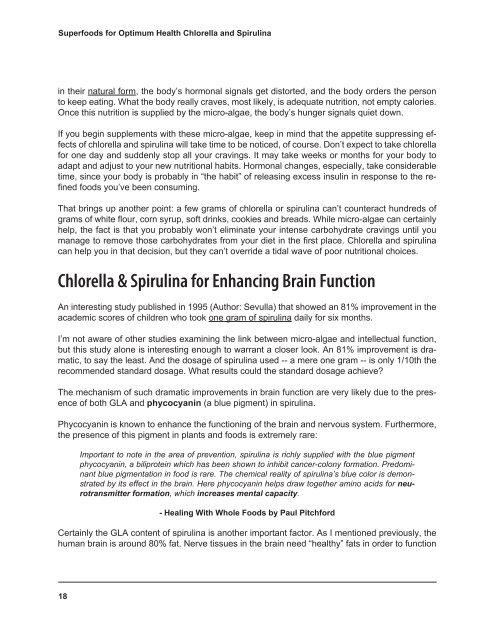BY MIKE ADAMS
BY MIKE ADAMS
BY MIKE ADAMS
You also want an ePaper? Increase the reach of your titles
YUMPU automatically turns print PDFs into web optimized ePapers that Google loves.
Superfoods for Optimum Health Chlorella and Spirulina<br />
in their natural form, the body’s hormonal signals get distorted, and the body orders the person<br />
to keep eating. What the body really craves, most likely, is adequate nutrition, not empty calories.<br />
Once this nutrition is supplied by the micro-algae, the body’s hunger signals quiet down.<br />
If you begin supplements with these micro-algae, keep in mind that the appetite suppressing effects<br />
of chlorella and spirulina will take time to be noticed, of course. Don’t expect to take chlorella<br />
for one day and suddenly stop all your cravings. It may take weeks or months for your body to<br />
adapt and adjust to your new nutritional habits. Hormonal changes, especially, take considerable<br />
time, since your body is probably in “the habit” of releasing excess insulin in response to the refined<br />
foods you’ve been consuming.<br />
That brings up another point: a few grams of chlorella or spirulina can’t counteract hundreds of<br />
grams of white flour, corn syrup, soft drinks, cookies and breads. While micro-algae can certainly<br />
help, the fact is that you probably won’t eliminate your intense carbohydrate cravings until you<br />
manage to remove those carbohydrates from your diet in the first place. Chlorella and spirulina<br />
can help you in that decision, but they can’t override a tidal wave of poor nutritional choices.<br />
Chlorella & Spirulina for Enhancing Brain Function<br />
An interesting study published in 1995 (Author: Sevulla) that showed an 81% improvement in the<br />
academic scores of children who took one gram of spirulina daily for six months.<br />
I’m not aware of other studies examining the link between micro-algae and intellectual function,<br />
but this study alone is interesting enough to warrant a closer look. An 81% improvement is dramatic,<br />
to say the least. And the dosage of spirulina used -- a mere one gram -- is only 1/10th the<br />
recommended standard dosage. What results could the standard dosage achieve?<br />
The mechanism of such dramatic improvements in brain function are very likely due to the presence<br />
of both GLA and phycocyanin (a blue pigment) in spirulina.<br />
Phycocyanin is known to enhance the functioning of the brain and nervous system. Furthermore,<br />
the presence of this pigment in plants and foods is extremely rare:<br />
8<br />
Important to note in the area of prevention, spirulina is richly supplied with the blue pigment<br />
phycocyanin, a biliprotein which has been shown to inhibit cancer-colony formation. Predominant<br />
blue pigmentation in food is rare. The chemical reality of spirulina’s blue color is demonstrated<br />
by its effect in the brain. Here phycocyanin helps draw together amino acids for neurotransmitter<br />
formation, which increases mental capacity.<br />
- Healing With Whole Foods by Paul Pitchford<br />
Certainly the GLA content of spirulina is another important factor. As I mentioned previously, the<br />
human brain is around 80% fat. Nerve tissues in the brain need “healthy” fats in order to function


